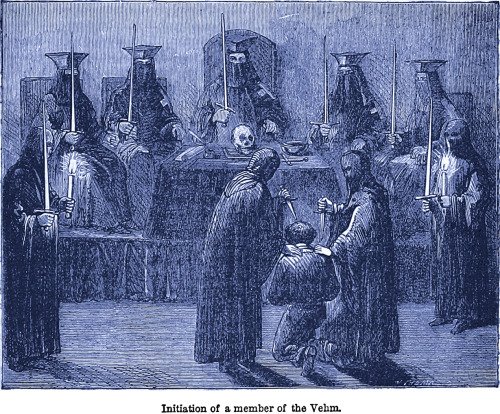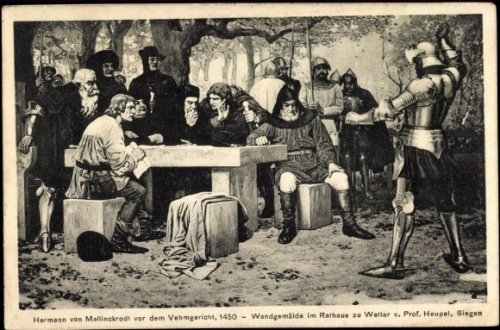
Born from the constant harassment from bandits and mercenaries in the German duchy of Westphalia, The Holy Vehm was established to bring order back to the region sometime in the late 13th century. Its name evolving from the Old German word of veme, punishment, to vehma, hidden justice.
Initially having the approval of the church and the Holy Roman Emperor, the order contained all classes of society, from the common freemen to Lords and Bishops. If anyone commited heresy, rape, theft, or turned from the church that person was in the order’s radar. No one was above their reach, be that person bandit or prince. This is how they received the ‘Holy’ moniker because they were, in essence, a Christian order to promote the 10 commandments and other Christian values.
Any free German man of pure blood and good character could serve the Vehm, these men were known as Schoeffen, ‘the ignorant’. In the initiation ritual, that could only be performed on Westphalian soil, the Schoeffen kneeled before the tribunal and swore an oath of service. The promised to guard the secrets of the order, and to never warn any accused that the order was looking for them, even if the accused was part of their family. A sword would be ran along the throat, slightly cutting the skin to draw blood and show what would happen if they ever revealed the secrets of the order. They were then given the secret password and identification, and a rope and a knife upon which were the letters S.S.G.G. - Stock, Stein, Gras, Grein - stick, stone, grass, tears.

The penalty for a member to reveal any secrets of The Holy Vehm was as follows: Their eyes would be ripped from their skulls, their tongue torn out from the back of the throat, and their body left to hang seven times higher than a normal criminal. If anyone was found at a trial that was not initiated, they would be immediately hung.
A Schoeffen would track down wanted persons – those who didn’t appear before the court, post citations for the accused to appear in front of the court, and watch their neighbors for any sign of criminality, ‘secret judge’. At the height of The Holy Vehms power in the second half of the 14th century they were said to have between 100,000 and 200,000 members.
If a Schoeffen was deemed worthy, they could advance into ranks such as Frohnboten (Bailiff/Executioners), Freischoffen (Deputy Judges), and Stuhlherren (Judges) who elected a president Freigraf (Free Count) – a position chosen for life.

The justice the Holy Vehm dished out started mild, but became more cruel as the order grew in power. The early days of the Holy Vehm, an accused could swear an oath to God on the cross, leave a farthing coin at the feet of the court, and walk free. But that was the early days, and that practice was soon done away with.
Most often the summons to appear in front of a Holy Vehm secret court was nailed to the door of the accused residence. If they had no residence, numerous summons would be nailed on places they were known to pass by. Once summoned you had three chances to voluntarily appear in front of the court, each chance was six weeks and three days apart – an old Saxon tradition. Most people didn’t go voluntarily as the secret courts were known for one punishment for any crime, death. If the accused tried to escape during any of those weeks the Schoeffen would be sent to track them down and immediately hang them. The Schoeffen would not take anything from the body and would leave one of their S.S.G.G. marked knives beneath the body to show that this was not a common murder.

If the accused somehow managed to convince the judges they were innocent, they would be set free. But, here’s the thing, they had seen and now know who the members of the Holy Vehm are. So Schoeffen would be sent to hunt them down and hang them. Damned if they did, damned if they didn’t. This caused the Vehm to be feared and they slowly lost their respect, lowering their support among the populace as time went on.
Well, that and the power of the Holy Vehm corrupted some of those in control of it. Who then used it for personal vengeance, accusing and then murdering people in the secret court for their own private quarrels.
Eventually the church and the government would condemn them, which caused the order to go underground even more and to cease most of the secret courts. By the 1800s they had very few members and remained that way until the 1930s when they became public again and threw their lot in with Hitler, initiating many Nazi officers. There are accounts of the Vehmic courts being held in the woods of France during WWII.
They are thought to have been finally wiped out during the fall of Hitler’s Germany at the end of WWII, but some people say that a few members survived and have initiated new recruits.
